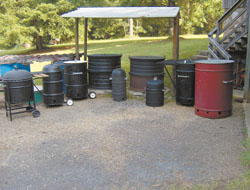
"You don't have to spend a lot of money to build your own barbeque grill," says Major Dunlap, Ozark, Alabama, who started a thriving sideline business selling barbeque grills that he makes out of scrap materials.
Two years ago FARM SHOW published a story on the low-cost grills he makes from 55-gal. drums (Vol. 31, No. 6). Since then he's come up with several other types and sizes, all made from scrap materials.
Key to success of his design is that the fire in each grill is cradled by a high-carbon steel harrow disc that rests on a 3-legged steel tripod inside the open-top drums. The discs can be set at two different heights. Meat cooks on a chrome-plated grate above the disc and also has two different settings. There are vent holes at the bottom of the drum and a metal lid on top to control the draft.
Each drum has its own cart, and a metal bracket supports the lid in the vertical position whenever it's not being used. A shelf for utensils and food bolts to the side of the drum.
"Fire never comes into contact with the drum's walls so it won't burn out. The discs are made from high carbon steel so they'll last virtually forever. In fact if you burn one out, we'll replace it," says Dunlap. "I guarantee my grills won't flame-up and burn the meat because of the way they're drafted. All my grills are equipped with a thermometer so you always know what your cooking temperature is."
All models use the same "disc harrow and tripod" idea. He uses 10, 15, 30, 85 and 110-gal. barrels. One grill is made from two 38-in. tractor wheels. Some of the smaller grills are set up on wheels. "The 10-gal. model makes a great tailgating grill," says Dunlap.
To make a grill from tractor wheels he simply clamps two wheels together. The lid is cut from a sheet of metal. He paints them with 500-degree engine paint. "We find it works best to put down a layer of brick to set the bottom wheel on. The brick keeps the fire off the ground," says Dunlap. "This grill has a lot of capacity. The body has an inside diameter of 36 in. which is enough room for 15 Boston butts, six slab ribs, or 20 chickens. I haven't sold any of these units yet, but they've been used at our church cookouts."
He also recycles old dome-lidded Weber grills. "Most of these grills are made from material that doesn't last long so the bottom eventually burns out. Most of the time all the customer brings me is the lid and sometimes the grate," says Dunlap.
To use the dome lids he cuts a 55-gal. barrel in half horizontally, leaving a 22 1/2-in. dia., 17-in. high body. Then he uses an old gas grill frame to make a cart for it.
Dunlap buys used drums from a carrot juice company that ships juice from California to Florida where it's frozen. He gets other drums from various sources, including parts stores that sell chain in barrels. He buys the discs from local farmers. "Most of the discs I buy started out as 24-in. dia. but eventually wore down to 16 to 18 in. diameter," he says.
"I'm willing to custom build grills for anyone who's interested," notes Dunlap.
